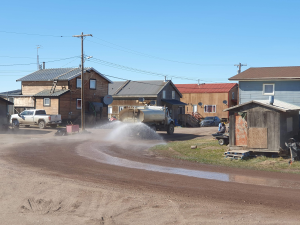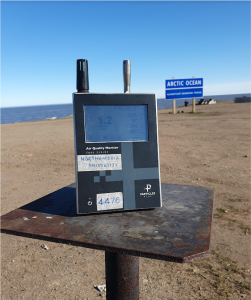Boston, USA – August 2024 – As the sun rises over the Arctic Circle, light filters through a grey haze blanketing the remote hamlet of Tukttoyatuk, Canada. While local residents embark on their daily routines across the dusty roads, they face an unsettling question:
How has this isolated corner of the Canadian Arctic, located 2,000 miles from the nearest major city, become enveloped in such a pervasive haze of dust?

Arctic haze is the seasonal accumulation of dust particulate matter (PM) and aerosols that remain suspended for months across the northern regions of Canada and Alaska. So where is all this dust coming from? The sub-tundra wilderness is crisscrossed with unpaved roads that serve small communities and large industrial sites. Vehicles traveling over these dry roads kick up fine dust particles, which linger in the air. These clouds, which extend upward for hundreds of meters, scatter light and retain heat, exacerbating the effects of global climate change. These suspended particles come in a range of sizes denoted by their subscript:
- PM2.5 (<2.5µm): Penetrates deep into the lungs, potentially causing respiratory and cardiovascular issues. It can also enter the bloodstream. Remains suspended in the air for extended periods due to its small size, making it challenging to filter out. Primarily from dust stirred up by traffic on unpaved roads, industrial activities, and other local sources. Contributes to light scattering and heat retention, exacerbating global climate change effects.
- PM10 (≤10µm): Can irritate the throat and lungs, potentially leading to chronic respiratory conditions. Less likely to penetrate deep into the lungs compared to PM2.5. While it eventually settles out of the air, it can remain suspended for shorter periods compared to PM2.5. Generated from road dust, construction activities, and other sources of coarse particulate matter. Settles on surfaces, including plants and homes, leading to contamination and increased maintenance challenges.
Where One Problem Ends Another Begins
After kicked-up dust particles fall out, toxic heavy metals and silica from the road dust settle onto plants and animals, bioaccumulating in ecosystems. Locals are frustrated that berries and plants they previously enjoyed foraging have become tainted and inedible. The dust also enters homes and settles on surfaces, adding an unpleasant grit to visitors’ meals.
With thousands of miles of unpaved roads and limited resources to tackle this dust problem, where do we even begin to solve it?
Professor Anil Namdeo and a team of researchers from Northumbria University set out to Tuktoyaktuk to find answers. Particles Plus is proud to report that Anil presented the team’s findings at the US Environmental Protection Agency’s 2024 National Ambient Air Monitoring Conference (NAAMC) in New Orleans, USA. This trailblazing work represents the furthest north researchers have ever monitored ambient air quality.
How a Remote Hamlet in the Canadian Tundra is Helping Scientists Understand Sources of Air PM Pollution
Researchers at Northumbria University have identified unpaved road dust as a significant component of Arctic PM air pollution. The Canada-Inuit Nunangat-United Kingdom Arctic Research Programme (CINUK) collaborated with Anil Namdeo’s team by funding a research initiative titled Project Nuna. ‘Nuna’ is the Inuvialuktun word for ‘land,’ ‘country,’ and ‘soil.’ The aim of their research was to explore the levels of airborne PM in the Tuktoyaktuk Hamlet in Northwest Territories, Canada. How much dust were the roads contributing to this problem? The research team also investigated the effectiveness of Tuktoyaktuk’s dust mitigation strategy, which involves routinely spraying roads with water to reduce dust kick-up.

Anil’s team used Particles Plus 7000 series aerosol monitors to measure ambient outdoor air quality at fixed points around Tuktoyaktuk. The stationary monitors observed traffic’s effect on local air quality throughout the day. The team rigged a vehicle with two 7000s units and drove between the airstrip and the hamlet center. This experiment showed how driving on unpaved roads affected in-cabin air quality and exterior (boot of the car) air quality. The team also tested how effective the hamlet’s dust mitigation strategy was. Did spraying the roads reduce dust, and how long did the effect last?
Key Findings:
- Anil’s team measured the air quality inside and outside a truck cabin while driving on the unpaved highway between the airstrip and hamlet center. Results indicated significantly higher PM concentrations in the boot of a truck compared to the air-conditioned front cabin, highlighting the potential risk of driving on these roads with the windows down.
- Stationary monitoring at 16 locations around Tuktoyaktuk revealed that PM5 concentrations correlated with traffic activity, with PM levels exceeding the Canadian Ambient Air Quality Standards (CAAQS) at the two most active areas in the hamlet. These findings underscore the risks of having unpaved infrastructure throughout work and lodging areas.
- The Hamlet Office’s practice of spraying water on unpaved roads proved effective in temporarily reducing PM5concentrations by 90%, although this effect was short-lived. This finding identifies a dust mitigation strategy which has a low environmental impact and is cost effective when deployed in a small region.
Significance of the Research:
This research provides critical insights into the sources and impacts of PM air pollution in the Arctic. By identifying key areas and activities contributing to PM emissions, the study offers valuable data to inform mitigation strategies aimed at protecting both environmental and human health in the region. The findings also emphasize the importance of ongoing collaboration and community engagement in addressing environmental challenges.
Particles Plus is proud to supply scientists around the world with quality-built air monitoring tools.

Particles Plus is proud to have supplied the 7000 series ambient air monitoring units used in this groundbreaking research. Our 7000 series particle counters offer unparalleled precision and reliability, making them the ideal choice for environmental studies in even the most challenging conditions. Designed for accuracy and durability, these monitors provide real-time data on particulate matter concentrations, helping researchers and environmental professionals understand and mitigate air pollution.
Our advanced particle counters are trusted by scientists worldwide to deliver consistent and accurate results. Whether it’s tracking particulate levels in urban areas or remote regions like the Canadian subarctic, Particles Plus provides the tools needed to make informed decisions about air quality and public health.
Read More about Cinuk and Project Nuna: